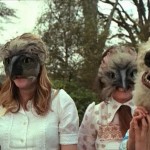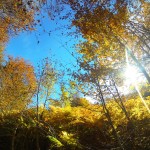I hate the suburbs. Which is ironic, because the white picket fence suburban ideal is one I chased for most of my life. Which is why I now live in the suburbs. But now I want to escape. I’m finding the whole idea of a yard absurd. Cultivating grass seems the height of insanity. Sidewalks are overrated. I long for mature trees and space where “weeds” can grow. The suburbs seem to me one of the most unreal places on the planet, surpassed only by professional office parks. Give me the woods. Give me farmland. Give me the city. Anything but the ‘burbs.
The other day, the “quiet desperation” which accumulates from living in a place like this moved from the background to the foreground, as it sometimes does, and I felt an overwhelming urge to flee. It was a crisp autumn evening. I put on my jacket, my gloves and my hat, and told my daughter, who was the only one home at the time, that I was going for a walk. Walk? I felt like running. I decided to leave my cell phone behind. But I got a half block away from my house and thought better of it. Half of me wanted to cut off all connection for a little while, while the other half wanted to make sure my daughter was okay. So I went back to the house and got the cell phone and told me daughter she could reach me on it if she needed to.
I set off again. The houses were illuminated by the soft glow of street lamps and the whole scene seemed both quaint and eerie. It reminded more than anything else of the nightmare nursery rhyme village in the caves under Lookout Mountain at Rock City, Georgia. It consists of caves filled with fairyland dioramas lit by blacklights, and it is one of the oddest tourist attractions I have ever seen. I don’t think it’s intended to be disturbing, but it is. Neil Gaiman describes it well in his book, American Gods:
“Rock City begins as an ornamental garden on a mountain side: its visitors walk a path that takes them through rocks, over rocks, between rocks. They throw corn into a deer enclosure, cross a hanging bridge, and peer out through a-quarter-a-throw binoculars at a view that promises them seven states on the rare sunny days when the air is perfectly clear. And from there, like a drop into some strange hell, the path takes visitors, millions upon millions of them every year, down into caverns, where they stare at black-lit dolls arranged into nursery-rhyme and fairy-tale dioramas. When they leave, they leave bemused, uncertain of why they came, of what they have seen, of whether they had a good time or not.”
That’s how I felt that night walking through my neighborhood that evening. The houses, which should have looked charming, seemed ominous. I could not make sense of what I was doing there. That I should live in this place seemed beyond comprehension. Of course I knew that people lived in these houses, but I could only imagine them occupied by mannequins. And I was one of the mannequins.
 A couple of turns and half mile from my house and the sidewalk came to an abrupt end near a creek — actually a drainage ditch. It’s the only place for miles where wild vegetation is allowed to grow freely. I really didn’t know where I was going. But I was looking for something. I followed the creek a little ways and came to a small hollow, set aside I think as a retention pond, mostly dry now and covered in grass, except for a tight grove of cattails in the center. The cattails stood taller than me, taller than I could reach. I went down the depression to where the cattails were growing in the spongy earth and sat down in the shadow of the little grove, grateful for a moment of unlikely privacy.
A couple of turns and half mile from my house and the sidewalk came to an abrupt end near a creek — actually a drainage ditch. It’s the only place for miles where wild vegetation is allowed to grow freely. I really didn’t know where I was going. But I was looking for something. I followed the creek a little ways and came to a small hollow, set aside I think as a retention pond, mostly dry now and covered in grass, except for a tight grove of cattails in the center. The cattails stood taller than me, taller than I could reach. I went down the depression to where the cattails were growing in the spongy earth and sat down in the shadow of the little grove, grateful for a moment of unlikely privacy.
And something happened.
The fall air was that kind that crisp that makes everything appear particularly clearly. The wind was blowing gently and the cattails waved back and forth like they were animate. And I felt, for all the world, like the cattails, the wind, that place … were talking to me. Not talking with words, but saying something nonetheless. What were they saying? I think this is what they said to me:
“This is real. You are here. You are alive.“
In Moby Dick, Melville wrote of the home island of Queequeg, “It is not down on any map; true places never are.” And this little spot was one such place too, a true place. A place that cannot be found on a map, because it is as more of an experience than a set of coordinates.
 I was less than a mile from my own house. I could see another subdivision off to my left a few hundred feet, houses lit from within, people living their lives inside. And even closer to my right was the road with occasional car traffic passing by. I still could hear the Interstate a half mile away. But in spite of all that, here in that place, in the shadow of the cattails, I felt connected again — connected to the mystery of life. And I was astonished that this little miracle could happen in such close proximity to that unreal world that I had fled from.
I was less than a mile from my own house. I could see another subdivision off to my left a few hundred feet, houses lit from within, people living their lives inside. And even closer to my right was the road with occasional car traffic passing by. I still could hear the Interstate a half mile away. But in spite of all that, here in that place, in the shadow of the cattails, I felt connected again — connected to the mystery of life. And I was astonished that this little miracle could happen in such close proximity to that unreal world that I had fled from.
Novalis calls this “romanticizing”, a word which has lost its original meaning, and now means a kind of naive idealization. “To romanticize the world,” writes Novalis, “is to make us aware of the magic, mystery and wonder of the world; it is to educate the senses to see the ordinary as extraordinary, the familiar as strange, the mundane as sacred, the finite as infinite.” We Pagans have another word for the same thing: enchantment — as in re-enchanting the world. It’s not about idealizing or “romanticizing”, in the pejorative sense of the word. I wasn’t pretending the cattails were sentient. It’s about experiencing the world as a subject, instead of as an object. It’s about experiencing the world as something that we are a part of, instead of standing separate from with an artificial objectivity. And it is not our natural way of being in the world, at least not anymore.
I stayed there for a little while, soaking in the feeling. And then I got up an went home. The houses still seemed strange to me. Unreal. The grass seemed artificial. Nothing had changed, except me. I had changed. I was healed a little bit. It’s the strangest thing. If anyone had seen me, they would have thought me insane, but it was the most sane thing I had done for weeks. I wondered what other true places my neighborhood might hide, waiting for me to discover them.
There is a place where the sidewalk ends
And before the street begins,
And there the grass grows soft and white,
And there the sun burns crimson bright,
And there the moon-bird rests from his flight
To cool in the peppermint wind.Let us leave this place where the smoke blows black
And the dark street winds and bends.
Past the pits where the asphalt flowers grow
We shall walk with a walk that is measured and slow,
And watch where the chalk-white arrows go
To the place where the sidewalk ends.Yes we’ll walk with a walk that is measured and slow,
And we’ll go where the chalk-white arrows go,
For the children, they mark, and the children, they know
The place where the sidewalk ends— Shel Silverstein, “Where the Sidewalk Ends”
ADDENDUM: Synchronistically, Traci Laird just published a piece about urban witchcraft and the methods she used to connect in an urban environment. Go check it out!












